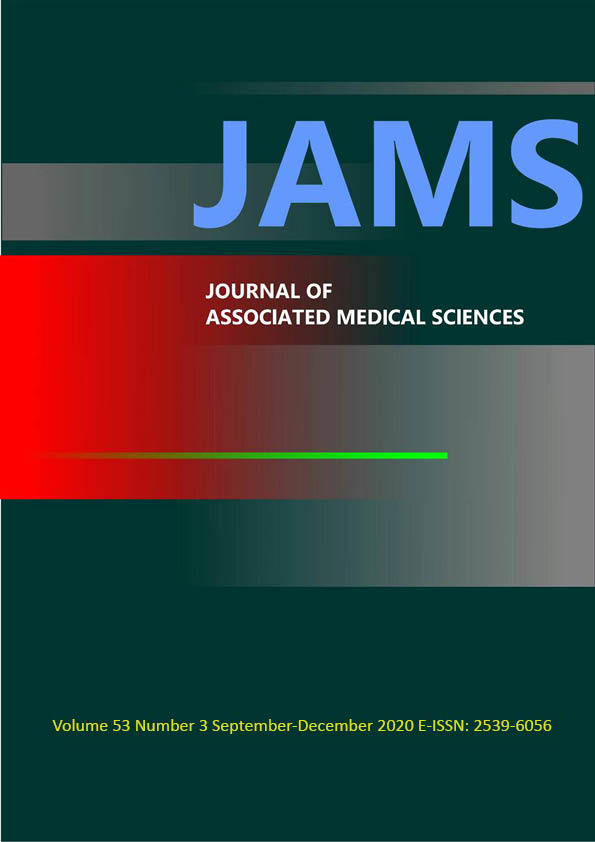Validation of Thai Smartphone Addiction Scale-short version for school students between 10 to 18 years
Main Article Content
Abstract
Background: With the dramatic increase in the number of smartphone users, concern has been raised that smartphone overuse can be hazardous to health. There is a need of smartphone addiction screening instrument that can be used for the Thai people, particularly children and adolescents.
Objectives: This study aimed to translate Smartphone Addiction Scale – Short Version (SAS-SV) into Thai for school students between 10 to 18 years and to comprehensively validate the translated version.
Materials and methods: After completing the translation according to published guidelines, Thai version of the SAS-SV (THAI-SAS-SV) for school students underwent thorough many psychometric tests. The content validity was evaluated by a panel of seven experts. Internal consistency and construct validity of the THAI-SAS-SV were then tested among 200 Thai school students between ages 10 and 18 (mean age 12.82±2.21 years). The test-retest reliability was also evaluated in half of all participants.
Results: THAI-SAS-SV for school students demonstrated an excellent validity index for scale (S-CVI = 0.97) and an item content validity index (I-CVI) ranging from 0.86 to 1.0. Cronbach’s alpha for internal consistency was calculated as 0.85. The THAI-SAS-SV for school students has similar construct to the original instrument because the confirmatory factor analysis clearly revealed a single-factor structure. Intraclass correlation coefficient (ICC) value for test retest reliability was 0.73 (95% CI: 0.62-0.81).
Conclusion: The findings suggest that THAI-SAS-SV for school students between 10 to 18 years is a valid and reliable instrument for screening smartphone addiction targeted towards Thai children and adolescents.
Article Details

This work is licensed under a Creative Commons Attribution-NonCommercial-NoDerivatives 4.0 International License.
Personal views expressed by the contributors in their articles are not necessarily those of the Journal of Associated Medical Sciences, Faculty of Associated Medical Sciences, Chiang Mai University.
References
World Health Organization [Internet]. Public health implications of excessive use of the internet, computers, smartphones, and similar electronic devices: meeting report. 2015 [cited 2019 Sep 4]. Available from: http://www.who.int /iris/handle/10665/184264.
De-Sola Gutiérrez J, Rodríguez de Fonseca F, Rubio G. Cell-phone addiction: a review. Front Psychiatry 2016; 7: 175. doi: 10.3389/fpsyt.2016.00175.
We Are Social [Internet]. Digital 2019: global internet use accelerates. 2019 [cited 2019 Sep 6]. Available from: https://wearesocial.com/blog/2019/01/digital-2019-global-internet-use-accelerates.
Newzoo [Internet]. Top 50 countries/markets by smartphone users and penetration. 2019 [cited 2019 Sep 11] Available from: https://newzoo.com/insights/rankings/top-50-countries-by-smartphone-penetration-and-users/.
DQ Institute [Internet]. 60% at Cyber-Risk. Thailand 4,652 4,960. Average DQ Screen Time Management Score Schools & Organizations Reached in 2017. 2018 [cited 2019 Sep 10]. Available from: https://docplayer.net/amp/90511553-60-at-cyber-risk-thailand-4-652-4-960-average-dq-screen-time-management-score-schools-organizations-reached-in-2017.html.
Pew Research Center [Internet]. Teens, social media & technology 2018. 2018 [cited 2019 Sep 2]. Available from: https://www.pewinternet.org/2018/05/31/teens-social-media-technology-2018/.
National Statistical Office of Thailand [Internet]. The ITU indicators from 2017 household survey on the use of information and communication technology [cited 2019 Sep 12]. Available from: http://www.nso.go.th/sites/2014en/itu
Charoenwanit S, Soonthornchaiya R. Development of Smartphone Addiction Scale: Thai Short Version (SAS-SV-TH). J Ment Health Thai 2019; 27(1): 25-36.
Kwon M, Kim D-J, Cho H, Yang S. The smartphone addiction scale: development and validation of a short version for adolescents. PLoS ONE 2013; 8(12): e83558. doi:10.1371/journal.pone.0083558.
Haug S, Castro RP, Kwon M, Filler A, Kowatsch T, Schaub MP. Smartphone use and smartphone addiction among young people in Switzerland. J Behav Addict 2015; 4(4): 299-307. doi:10.1556/ 2006.4.2015.037.
Lopez-Fernandez O. Short version of the smartphone addiction scale adapted to Spanish and French: towards a cross-cultural research in problematic mobile phone use. Addict Behav 2017; 64: 275-80.
Samaha M, Hawi NS. Relationships among smartphone addiction, stress, academic performance, and satisfaction with life. Comput Human Behav 2016; 57: 321-25. doi.org/10.1016/j.chb.2015.12.045.
Akın A, Altundağ Y, Mehmet ET, Turan ME, AKm U. The validity and reliability of the Turkish version of the smart phone addiction scale-short form for adolescent. Procedia Soc Behav Sci 2014; 152: 74-7. doi:10.1016/j.sbspro.2014.09.157.
De Pasquale C, Sciacca F, Hichy Z. Italian validation of smartphone addiction scale short version for adolescents and young adults (SAS-SV). Psychology 2017; 8: 1513-18. doi:10.4236/psych.2017.810100
Luk TT, Wang MP, Shen C, Wan A, Chau P H, Oliffe J, et al. Short version of the Smartphone Addiction Scale in Chinese adults: psychometric properties, sociodemographic, and health behavioral correlates. J Behav Addict 2018; 7(4): 1157–65. doi:10.1556/20 06.7.2018.105.
Phanasathit M, Manwong M, Hanprathet N, Khumsri J, Yingyeun R. Validation of the Thai version of Bergen Facebook Addiction Scale (Thai-BFAS). J Med Assoc Thai 2015; 98(2): S108-17.
Pornnoppadol C, na Ayudhaya SL, Phoasavasdi C, Surapongphiwattana T. Development of Game Addiction Protection Scale (GAME-P). J Psychiatr Assoc Thailand 2017; 62(1): 3-16.
Kwon M, Lee JY, Won WY, Park JW, Min JA, Hahn C, et al. Development and validation of a smartphone addiction scale (SAS). PLoS ONE 2013; 8(2): e56936. doi:10.1371/journal.pone.0056936.
Beaton DE, Bombardier C, Guillemin F, Ferraz MB. Guidelines for the process of cross-cultural adaptation of self-report measures. Spine 2000; 25: 3186-91. doi:10.1097/00007632-200012150-00014.
Nunnally JC. Psychometric Theory. 2nd ed. New York: McGraw-Hill; 1978.
Terwee CB, Bot SD, de Boer MR, van der Windt DA, Knol DL, Dekker J, et al. Quality criteria were proposed for measurement properties of health status questionnaires. J Clin Epidemiol 2007; 60: 34-42. doi:10.1016/j.jclinepi.2006.03.012.
Bolarinwa OA. Principles and methods of validity and reliability testing of questionnaires used in social and health science researches. Niger Postgrad Med J 2015; 22(4): 195-201.
Polit DF, Beck CT. The content validity index: are you sure you know what's being reported? critique and recommendations. Res Nurs Health 2006; 29: 489-97. doi:10.1002/nur.20147.
Kline RB. Principles and practice of structural equation modeling. New York: Guilford Press; 1998.
Nunnally JC, Bernstein I. Psychometric theory. 3rd ed. New York: McGraw-Hill; 1994.
De Vellis RF. Scale development: theory and applications. 3rd ed. California: SAGE Publications; 2012.
Rosenberg KP, Feder LC. Behavioral addictions: criteria, evidence, and treatment. Amsterdam: Elsevier/Academic Press; 2014.
Koo TK, Mae YL. A guideline of selecting and reporting intraclass correlation coefficients for reliability research. J Chiropr Med 2016; 15: 155-63.
American Psychological Association [Internet]. Developing adolescents: a reference for professionals. 2002 [cited 2019 Sep 11]. Available from Retrieved from https://www.apa.org/pi/families/resources/ develop.pdf.


